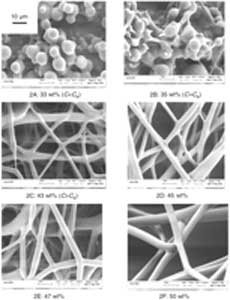| Posted: Jan 25, 2006 |
|
Scientists develop process for creating biocompatible fibers
|
|
(Nanowerk News) Scientists at Virginia Tech have developed a single-step process for creating nonwoven fibrous mats from a small organic molecule – creating a new nanoscale material with potential applications where biocompatible materials are required, such as scaffolds for tissue growth and drug delivery.
|
|
The research was presented in the Jan. 20, 2006 issue of Science, in the article, "Phospholipid Nonwoven Electrospun Membranes," by Matthew G. McKee, a recent Ph.D. graduate in chemical engineering from Virginia Tech’s College of Engineering, now at P&G, current chemistry students John M. Layman and Matthew P. Cashion, and chemistry professor Timothy E. Long, all at Virginia Tech’s College of Science.
|
 |
FESEM images of electrospun phospholipids (Ce = 35 wt %) (Source and Copyright: Science) |
|
"Phospholipids, which are the main component of cell membranes in the human body or in an apple are exquisite in terms of their ability to self-organize," said Long. The researchers fabricated this natural compound into a sub micron fiber – 100 times smaller than a human hair. "It is the first demonstration that electrostatic spinning, or electrospinning, a polymer processing technique, can be used with a small molecule to produce a fiber. "Clothing fibers such as polyesters and nylons are composed of large molecules, macromolecules," Long said. "Now, we are fabricating fibers from small molecules – ones with a low molecular weight." Under the microscope, the resulting mat shows a porous nonwoven structure.
|
|
The researchers used a commercial product, lecithin, a natural mixture of phospholipids and neutral lipids. The materials will spontaneously organize into cylindrical or worm-like strands to form membranes. McKee studied this self-assembly and conducted rheological experiments to fundamentally understand the association of small molecules, then he determined that once phospholipids form an entangled network they can be treated similarly to higher weight molecules and electrospun. The size of the mats is limited only by the amount of material, such as lecithin.
|
|
"This represents the synergy of electrospinning, the use of self-organizing molecules, and fundamental research to understand the behavior of such molecules," Long said. "Matt (McKee) did a terrific job of bringing fundamental learning to a potentially new family of fabrics and membranes." Long said that the future opportunities are vast. "Our research group continues to fabricate molecules that self organize and can be electrospun. Potential applications include drug delivery, that is, a carrier and matrix to control the release of drugs."
|
|
Long's research group is working with Virginia-Maryland Regional College of Veterinary Medicine researchers at Virginia Tech to develop a patch for drug delivery for horses. "We have not yet tested the specific biocompatibility (cytotoxicity) of our fibers, but we have not changed the chemical structure of the phospholipids."
|
|
The research is part of the Army Research Office Multidisciplinary University Research Initiative (MURI), which brings together chemistry, mechanical engineering, electrical engineering, chemical engineering, and materials science researchers to accelerate discoveries in nanostructured materials.
|

